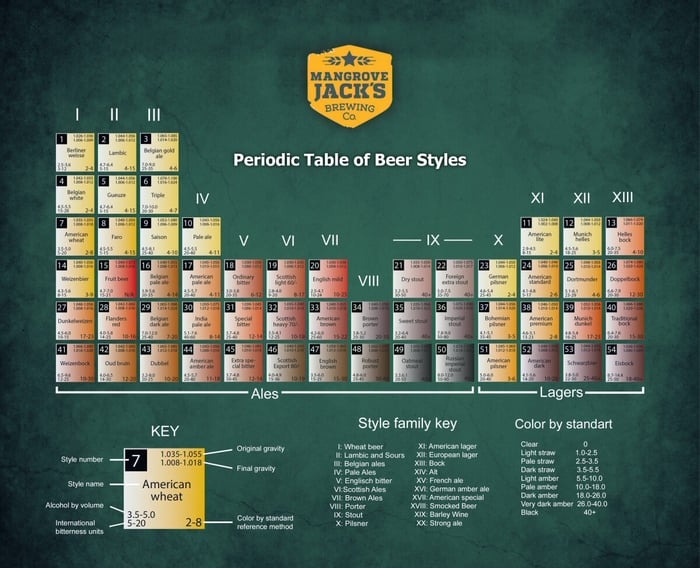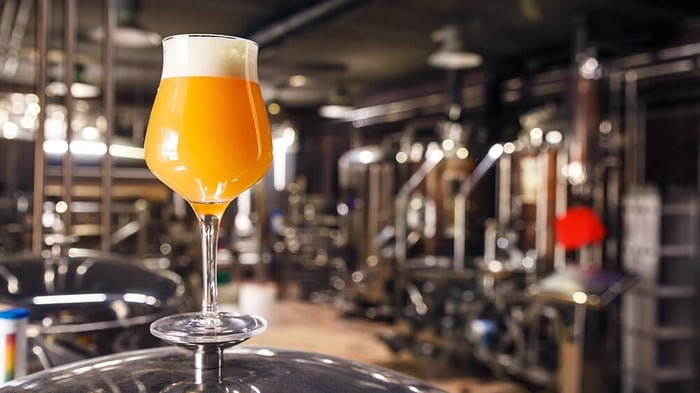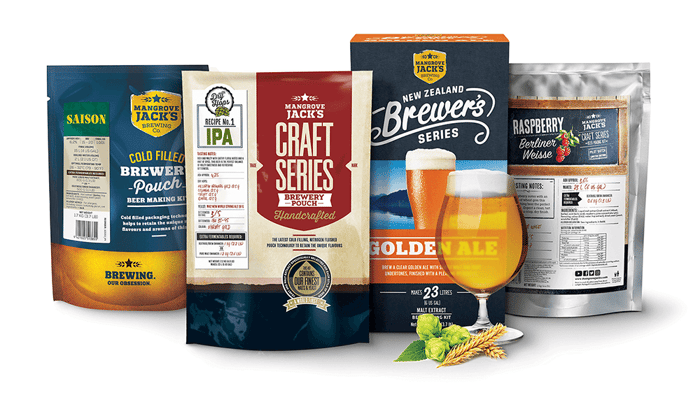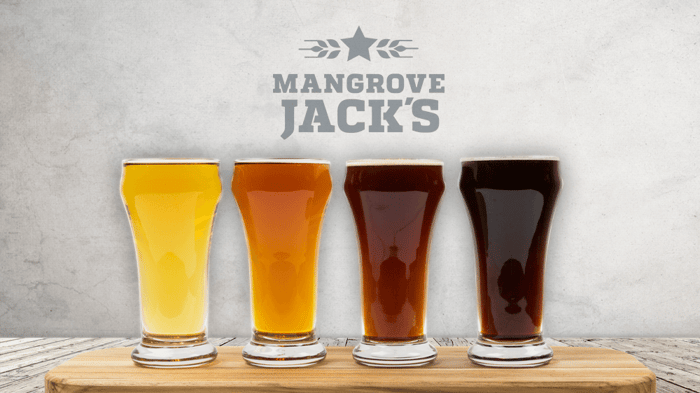To help you better understand the range of craft beers out there, we have put together this brief guide to beer styles (or at least, the main ones available)!
The variety of beers out there are seemingly endless and can be a bit overwhelming when deciding what to make or drink. Whether you’re looking for a new brew to ferment or standing in line at a craft beer bar, the ‘uuuhhhh’ going through your head as you make a choice can go on for a while!
To help you avoid this situation, our Mangrove Jack's brewers have put together some info so that you know what you’re getting rather than being surprised with the first sip.
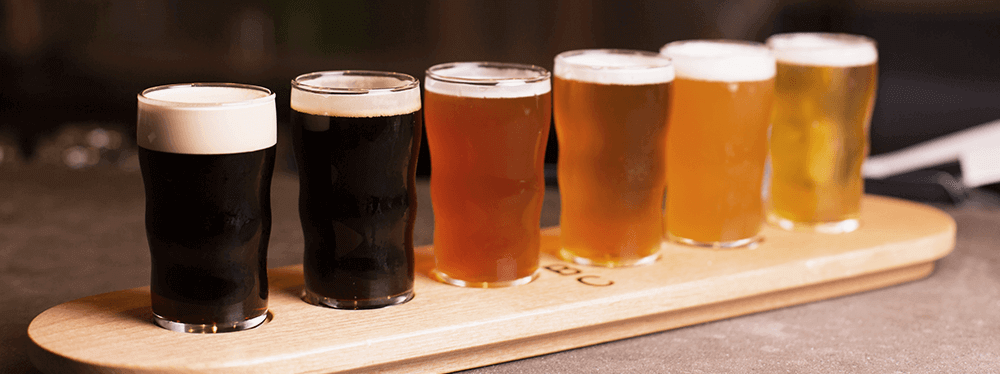
Lagers and Ales
Most beers can be categorised as lagers or ales – this is determined by the yeast used during the fermentation of the beer.
- Lager yeast produces fewer fruity flavours which results in crisper, more neutral fermentation flavours. This allows the malts and the hops to shine.
- Ale yeast on the other hand tends to produce more fruity fermentation flavours which complement the hops and malts used.
Your lager or ale then has sub-categories to further differentiate between various colours, flavours and aromas in each brew. Once you know what style you prefer, it becomes easier to choose what you’re going to brew next. A floral, hoppy pilsner with bitter base notes perhaps? Or does a thick, chocolate stout appeal more for the winter months?
This is by no means an exhaustive list, but it will give you a brief overview of some of the more common types of beer.
| Pale Lager and Pilsner | ABV | IBU | |
| American Light Lager | A lower ABV version of the American lager | 2.8-4.2% | 8-12 |
| American Lager | On the lighter side in flavour, colour and alcohol content. | 4.2 – 5.3% | 8 – 18 |
| Munich Helles | Bright gold colour and a stronger malt flavour than a traditional pilsner. | 4.7 – 5.4% | 16 – 22 |
| German Pils | Pale gold colour with a medium hop flavour and some malt notes. | 4.4 – 5.2% | 22 – 40 |
| Czech/Bohemian Pilsner(premium pale lager) | Bitter hop flavour with a floral aroma. Straw-coloured beer. | 4.2 – 5.8% |
30 – 45 |
Amber Lagers
Malty amber-coloured lager with an interesting caramel or toast quality and restrained bitterness. Smooth, easy-drinking lager character.
| Amber Lagers | ABV | IBU | |
| International Amber Lager | Strong malt flavours with different levels of hop flavour. Darker colour, caramel aroma and smooth taste. | 4.6 – 6.0% | 8 - 25 |
| Oktoberfest/Festbier/German Style Marzen |
A full bodied beer with a dark copper colour and rich, toasted flavour. |
5.8 – 6.3% |
18 – 24 |
| Vienna Lager | A moderate-strength amber lager with a soft, smooth maltiness and moderate bitterness, yet finishing relatively dry. | 4.7 – 5.5% | 18 – 30 |
Dark Lagers
Stronger and smoother than other lagers, this intensely flavoured brew comes from the town of Einbeck. This beer style is often associated with special occasions or holidays.
| Dark Lagers | ABV | IBU | |
| German Schwarzbier | A dark beer with a relatively light flavour, a slight sweetness with malt notes. | 3.8 – 4.9% | 22 – 30 |
| International Dark Lager | A darker and somewhat sweeter version of international pale lager with a little more body and flavour, but equally restrained in bitterness | 4.2-6.0% | 8-20 |
| Dunkles Bock | Dark copper colour with a malty sweet flavour. | 6.3 – 7.2% | 20 – 27 |
| Doppelbock | Stronger than the traditional bock with a higher alcohol content and fuller body. | 7.0 – 10% | 16 – 26 |
| Weizenbock | A wheat bock with fruity, malt flavours. | 6.5 – 9.0% | 15 – 30 |
Click here to see all Lager recipes in the Mangrove Jack's Blog!
- Ales -
Brown Ales
Originally a descriptor for porters and stouts, brown ales date back to the early 1700s in England. Malty, sessionable and delicious.
| Brown Ales | ABV | IBU | |
| American Brown Ale | A dark caramel colour with a medium to full bodied profile. Less bitterness than porters and stouts. Hopped with American Hops. | 4.3 – 6.2% | 20 – 30 |
| English Brown Ale | Dark beer with a nutty malt flavour and a caramel aroma. | 4.2 – 5.4% | 20 – 30 |
| English Dark Mild | Low hop bitterness with malt and caramel flavours. | 3.0 – 3.8% | 10 - 25 |
Pale Ales
A more recent addition to the beer variety market - only 300 years old or so. A low level bitterness with hop flavours popping through.
| Pale Ales | ABV | IBU | |
| American Pale Ale | A light copper coloured beer with medium body and a distinct hop flavour. | 4.5 – 6.2% | 30 – 50 |
| Blonde Ale | A light fruity aroma with balanced malt and hops flavours. | 3.8 – 5.5% | 15 – 28 |
| English Ordinary Bitter | A strong bitter note from the hops, fruity notes and generally a lower alcohol content. | 3.2 – 3.8% | 25 – 35 |
| English Strong bitter | A strong hop flavour, balanced by a sweet malt. | 4.6 – 6.2% | 30 – 50 |
India Pale Ales (IPA)
With a strong bitter note and upfront hoppy flavours, The IPA was first born in England and quickly became popular with the East India Company who exported it. It was later revived during the craft beer revolution in the USA.
| India Pale Ales (IPA) | ABV | IBU | |
| American IPA | Higher level of bitterness compared to a pale ale, herbal or citrus flavours and lots of hops. | 6.3 – 7.5% | 50 – 70 |
| Imperial or Double IPA | Same base flavours as an American IPA but with stronger hop bitterness, flavour and a higher alcohol content. | 7.0 – 14.0% | 65 – 100 |
| English IPA | Same base flavours as an American IPA but with a reduced hop flavour and lower alcohol content. | 5.0 – 7.0% | 35 – 63 |
| New England IPA | Dry hopping techniques give a juicy, tropical note to these IPAs. | 6.3 – 7.5% | 50 – 70 |
Click here to see all Ale recipes in the Mangrove Jack's Blog!
Porters
Often used interchangeably with the term stout, porter beers have a distinct roasted flavour and are usually higher in alcohol content.
| Porters | ABV | IBU | |
| American Porter | A malty sweet taste with a dark colour. | 4.8 - 6.5% | 25 – 50 |
| English Porter | Similar to an American style porter but with a lower alcohol content and reduced malt sweetness. | 4.0 – 5.4% | 18 – 35 |
Click here to see all Porter recipes in the Mangrove Jack's Blog!
Stouts
Historically every strong beer was called a ‘stout’, however it is actually just the more full-bodied version of a porter. Lots of full flavours in the chocolate and coffee realm.
| Stouts | ABV | IBU | |
| American Stout | Strong chocolate and coffee notes with malt flavours tying in. Medium hop bitterness. | 5.0 – 7.0% | 35 – 75 |
| Imperial Stout | A deep black colour with strong malty flavours. | 8.0 – 12.0% | 50 – 90 |
| Oatmeal Stout | Oatmeal is used in the malt blend giving a sweetness and smooth body. | 5.5 – 8.0% | 30 – 50 |
| Sweet Stout | Lactose sugar is used during fermentation adding sweet caramel and chocolate notes. | 4.0 – 6.0% | 20 - 40 |
| Irish Stout |
Black in colour with a higher bitterness from the roasted barley used. | 4.0– 4.5% | 25 – 45 |
Belgian Styles
| Belgian Styles | ABV | IBU | |
| Belgian Blonde Ale | Easy drinking with a slight bitterness, low malt aroma and spiced or fruity character. | 6.0 – 7.5% | 15 - 30 |
| Belgian Pale Ale | A pale ale with a subtle toasted malt flavour and notes of hops. | 4.8 – 5.5% | 20 – 30 |
| Belgian Dubbel | Rich, malt flavour with hints of fruit and spice. | 6.0 – 7.6% | 20 – 35 |
| Belgian Tripel | Light bodied beers with a slight hoppy bitterness and a high alcohol content. | 8.0 – 12.0% | 20 – 35 |
| Belgian Strong Dark Ale | Complex fruit flavours and a high alcohol content. | 4.0– 4.5% | 25 – 45 |
| Belgian Saison (standard) |
Also known as farmhouse ales, saisons have a medium hop and earthy flavour. | 5.0 – 7.0% | 20 – 35 |
Wheat Beers
| Wheat Beers | ABV | IBU | |
| American Pale Wheat | Light straw colour with a bready flavour and lower alcohol content. | 3.5 – 5.6% | 10 – 35 |
| Belgian Witbier | A white-coloured beer with a light, fruity flavour. | 4.8 – 5.6% | 10 – 17 |
| Dunkelweizen | A golden darker beer with a malt flavour and hints of banana. | 4.8 – 5.4% | 10 – 15 |
| Hefeweizen | A light coloured wheat beer with hints of apples and sometimes cloves. A crisp finish. | 4.9 – 5.6% | 10 - 15 |
Wild and Sour Ales
All sour ales are considered wild, but not all wild ales are sour. With the addition of bacteria and specific yeasts, wild beer styles are fast becoming popular with beer lovers worldwide.
| Wild and Sour Ales | ABV | IBU | |
| American Sour | Sour notes balanced with wild, fruity flavours produced by bacteria during fermentation. | Varies | Varies |
| American Brett | Fruity, acidic character form the bacteria used, classified as a wild beer, not a sour. | Varies | Varies |
| Berliner Weisse | A tart, sour beer with a pale colour and lower alcohol content. | 2.8 – 3.8% | 3 – 8 |
| Belgian Fruit Lambic | Brewed with fruit to get intense, but balanced sweet and sour flavours. | 5.0 – 7.0% | 0 – 10 |
| Flanders Red Ale | A strong sour taste with malt and fruit notes coming through. | 4.6 – 6.5% | 10 – 25 |
| Belgian Gueuze | A complex, pleasantly sour but balanced wild Belgian wheat beer that is highly carbonated and very refreshing | 5.0 – 8.0% | 0-10 |
| Belgian Oud Bruin |
A malty, fruity, aged, somewhat sour Belgian-style brown ale. | 4.0 – 8.0% | 20-25 |
Click here to see all Sour Ale recipes in the Mangrove Jack's Blog!
Specialty Beers
This umbrella term covers any type or style of brew that has a specific ingredient added to it. With so much experimentation going on and unique craft brews popping up everywhere, most of these don’t fall into a traditional category and are considered specialty.
Below: A handy guide to the distinguishing characteristics of popular beer styles!

